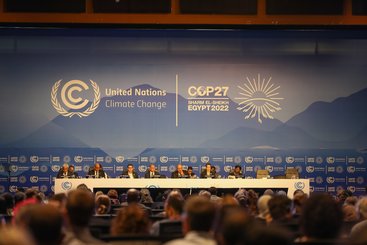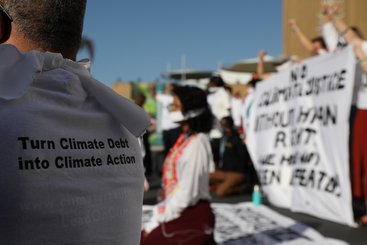One of the fiercest points of contention in the closing hours of COP27 was the question of who should provide climate finance. This question has been raised regularly in the climate negotiations over the last decade, but flared up again in deliberations around the new loss and damage fund.
The UN climate convention does not specify which countries should provide climate finance. Currently, ‘developed countries’ are expected to provide and mobilise $100 billion a year (and are failing to do so). However, there is no definition of ‘developed’ under the convention, so observers and negotiators tend to revert back to its 1992 Annex country list: the then members of the OECD and European Commission (Annex II) and all other countries (non Annex II).
But the world has changed radically since 1992. Many countries have seen considerable economic growth, typically accompanied by even greater increases in emissions. Yet only a handful of those richer, more polluting countries have opted to step up as climate finance providers, particularly South Korea and several Eastern European nations.
The climate negotiations in Sharm El Sheikh hit a bottleneck because of a fierce debate about which additional countries – beyond that 1992 list – should begin to pay. But the negotiations were largely based on geopolitical tensions, not empirical data.
This blog fills that gap, enabling a more evidence-based discussion about how to expand the climate finance contributor base. Our analysis is not necessarily intended to encourage new donors to help meet the longstanding $100 billion commitment. Rather, it is intended to support negotiations around the New Collective Quantified Goal, (NCQG), which replaces the $100 billion target from 2025, as well as the loss and damage fund that will be finalised over COP28 and COP29.
Who should be providing and mobilising climate finance?
Our new analysis should be understood in the context of our report, A fair share of climate finance?. In this report, we offered two criteria for an expanded contributor base: ability to pay (as measured by per capita incomes in 2020) and responsibility for climate change (as measured by cumulative territorial emissions since 1990).
Using these metrics, we identified two groups of countries that potentially qualify as providers of climate finance:
- Israel, Qatar and Singapore (if we use the benchmark that new contributors should have per capita incomes and per capita cumulative territorial emissions higher than at least five Annex II countries)
- Brunei, Kuwait, South Korea and the UAE (if we use the benchmark that new contributors should have per capita incomes and per capita cumulative territorial emissions higher than at least three Annex II countries)
How much climate finance should they be providing and mobilising?
We attribute each country’s 'fair share' of climate finance based on (1) Gross National Income and (2) cumulative territorial emissions since 1990.
Using these metrics and assuming that Israel, Qatar and Singapore were added to the contributor base, they would collectively be expected to provide 1.8% of the new climate finance goal – whatever the agreed figure – based on their GNI or 1.5% of the new climate finance goal based on their historical emissions.
If these three countries plus Brunei, Kuwait, South Korea and the UAE were added to the contributor base, they would collectively be expected to provide 6.0% of the climate finance goal based on their GNI or 7.3% of the climate finance goal based on their historical emissions.
In short, expanding the climate finance contributor base according to income and emission levels seems to have the potential to significantly expand the total resource envelope. However, this is overwhelmingly due to the inclusion of South Korea, which would have a 'fair share' (under the expanded definition for new contributors) of 3.3% of the new goal based on its GNI and 4.2% based on its emissions.
But South Korea already chooses to contribute to the $100 billion a year goal. And – as with all other donors – there is no mechanism requiring it to pay its fair share. This real-world example suggests that expanding the contributor base may have a relatively negligible impact on the total quantity of climate finance, although the symbolic value could be significant.
What about China?
Much of the debate around expanding the climate finance contributor base has fixated on China. The Economist, New York Times and Washington Post have all pointed the finger of blame east, often on dubious scientific grounds.
However, China does not qualify as a climate finance provider under our proposed criteria. Both its per capita income and its per capita territorial cumulative emissions since the 1990s fall below any Annex II countries.
Per capita incomes of the five largest Annex countries compared with China
| Country | Per capita incomes (US$, 2020) |
|---|---|
| China | 10,550 |
| France | 39,653 |
| Germany | 47,540 |
| Japan | 42,498 |
| United Kingdom | 40,514 |
| United States | 64,213 |
Per capita emissions of the five largest Annex countries compared with China
| Country | Per capita emissions (tCO2, 1990-2018) |
|---|---|
| China | 128 |
| France | 164 |
| Germany | 290 |
| Japan | 269 |
| United Kingdom | 239 |
| United States | 530 |
While Western media and politicians may say that China should become a climate finance contributor because it is a rich country or a major emitter, these claims are not consistent with our findings. Rather, demands that China become a climate finance contributor are based on geopolitics, particularly China’s status as global power and international financier.
What could really shift the needle on climate finance?
The real game changer in terms of volume of climate finance would be to have a burden-sharing mechanism for climate finance in the UN climate convention. Such a mechanism could assess each developed country’s fair share of the climate finance target, rather than treat it as a collective goal – and that would improve accountability.
At the moment, the absence of any burden-sharing mechanism allows developed countries like Australia, Canada and the US to shirk their responsibilities. Australia and Canada provide just a quarter of their fair share of the $100 billion target, while the USA provides less than 5%. If the US alone were to provide its fair share of the $100 billion target based on its Gross National Income and cumulative emissions, that would unlock an additional $40 billion for international climate action.
If such a burden-sharing mechanism were introduced as part of the New Collective Quantified Goal and China should choose to contribute climate finance, that would certainly increase the resources for mitigation and adaptation. Should China opt in to climate finance provision and be subject to such a burden-sharing mechanism, its fair share of the new goal based on GNI would be 24% and its fair share based on cumulative emissions would be 36%.
However, the reality is that a burden-sharing mechanism is unlikely –and not because of opposition from China. The US remains the great laggard on climate finance and fiercely opposed to any mechanism that would hold it to account. Negotiators, politicians and campaigners would therefore do well to focus on its continued shortfall rather than looking towards China.




